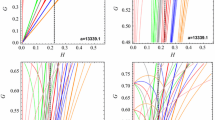Abstract
Infinite series expansions are obtained for the doubly averaged effects of the Moon and Sun on a high altitude Earth satellite, and the results used to interpret numerically integrated examples. New in this paper are: (1) both sublunar and translunar satellites are considered; (2) analytic expansions include all powers in the satellite and perturbing body semi-major axes; (3) the fact that retrograde orbits have more benign eccentricity behavior than direct orbits should be exploited for high altitude satellite systems; and (4) near circular orbits can be maintained with small expenditures of fuel in the face of an exponential driving force one forI a<I<Ib, whereI b=180°−I a andI a is somewhat less than 39.2° for sublunar orbits and somewhat greater than 39.2° for translunar orbits.
Similar content being viewed by others
Abbreviations
- a :
-
semi-major axis
- A lk :
-
coefficient defined in Equation (11)
- B lk :
-
coefficient defined in Equation (24)
- C km :
-
coefficient defined in Equation (25)
- D, E, F :
-
coefficients in Equations (38), (39)
- e :
-
eccentricity
- H k :
-
expression defined in Equation (34)
- \(\bar H_t \) :
-
expression defined in Equation (35)
- I :
-
inclination of satellite orbit on lunar (or solar) ring plane
- J 2 :
-
coefficient of second harmonic of Earth's gravitational potential (1082.637×10−6 R 2E )
- K k, Lk, Mk :
-
expressions in Section 4
- \(\bar K_l , \bar L_l , \bar M_l \) :
-
expressions in Section 4
- p=a(1−e 2):
-
semi-latus rectum
- P l :
-
Legendre polynomial of degreel
- q :
-
argument of Legendre polynomial
- \(r = \frac{p}{{1 + e\cos \psi }}\) :
-
radial distance of satellite
- R E :
-
Earth equatorial radius (6378.16 km)
- R, S, W :
-
perturbing accelerations in the radial, tangential and orbit normal directions
- syn:
-
synchronous orbit radius (42 164.2 km=6.6107R E)
- t :
-
time
- T :
-
satellite orbital period
- T′:
-
orbital period of perturbing body (Moon)
- T e :
-
period of long periodic oscillations ine for |I|<I a
- T s :
-
synodic period
- U :
-
gravitational potential of lunar (or solar) ring
- x, y, z :
-
Cartesian coordinates of a satellite with (x, y) being the ring plane
- γ:
-
coefficient defined in Equation (20)
- Δβ:
-
average change in orbital element β over one orbit (β=a, e, I, Ω, ω)
- ɛ1,ɛ2ɛ3 :
-
unit vectors in thex, y, z coordinate directions
- ɛ r ,ɛ s ,ɛ w :
-
unit vectors in the radial, tangential and orbit normal directions
- η=ω+ψ:
-
angle along the orbital plane from the ascending node on the ring plane to the true position of the satellite
- θ:
-
angle around the ring
- μ:
-
gravitational constant times mass of Earth (3.986 013×105 km s−2)
- μ′:
-
gravitational constant times mass of Moon (or Sun)
- μ m :
-
gravitational constant times mass of Moon (μ/81.301)
- μ s :
-
gravitational constant time mass of Sun (332 946 μ)
- π:
-
ratio of the circumference of a circle to its diameter
- ϱ:
-
radius of lunar (or solar) ring
- ϱ m :
-
radius of lunar ring (60.2665R E)
- ϱ s :
-
radius of solar ring (23455R E)
- ψ:
-
true anomaly
- ω:
-
argument of perigee
- ω0 :
-
initial value of ω
- μ i :
-
critical value of ω in quadranti(i=1, 2, 3, 4)
- Ω:
-
longitude of ascending node on ring plane
References
Ash, M. E.: 1974, Lincoln Laboratory, M.I.T., Technical Note 1974-5.
Cook, G. E.: 1962,Geophys. J. Roy. Astron. Soc. 6, 271.
Gradsheteyn, I. S. and Ryzhik, I. M.: 1975,Tables of Integrals, Series and Products, Academic Press, New York and London, pp. 152–153.
Kozai, Y.: 1959, Smithsonian Astrophysical Observatory Special Report No. 22.
Lidov, M. L.: 1962a,Planet. Space Sci. 9, 719.
Lidov, M. L.: 1962b, in M. Roy (ed.),International Symposium on the Dynamics of Satellites (Paris), Springer, Berlin, p. 168.
Lorell, J.: 1965,J. Astronaut. Sci. 12, 142.
Lorell, J.: 1966, Jet Propulsion Laboratory, CIT, Technical Memorandum 33-287.
Musen, P., Bailie, A., and Upton, E.: 1961, NASA Goddard Spaceflight Center Technical Note D-494.
Shapiro, I. I.: 1962, in M. Roy (ed.),International Symposium on the Dynamics of Satellites (Paris), Springer, Berlin, p. 257.
Smart, W. M.: 1953,Celestial Mechanics, Longmans, Green and Co., London, p. 218.
Walker, J. G.: 1970, Royal Aircraft Establishment Technical Report 70211.
Walker, J. G.: 1971,J. Brit. Interplanet. Soc. 24, 369.
Walker, J. G.: 1973, IEE Satellite Systems for Mobile Communications Conference, Paper No. 95.
Williams, J. G. and Benson, G. S.: 1971,Astron. J. 76, 167
Williams, R. R. and Lorell, J.: 1966, Jet Propulsion Laboratory CIT, Technical Report 32-916.
Author information
Authors and Affiliations
Additional information
This work was sponsored by the Department of the Air Force.
Rights and permissions
About this article
Cite this article
Ash, M.E. Doubly averaged effect of the Moon and Sun on a high altitude Earth satellite orbit. Celestial Mechanics 14, 209–238 (1976). https://doi.org/10.1007/BF01376321
Received:
Issue Date:
DOI: https://doi.org/10.1007/BF01376321




